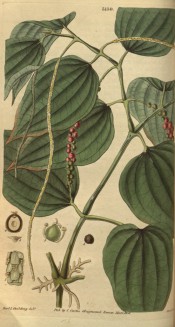Piper nigrum L.
Trailing or climbing shrub with ovate, pointed leaves, to 15cm long and spikes of minute flowers followed by green fruit, ripening through red to black. [RHSD, Hortus].
Horticultural & Botanical History
‘It is a native of the hotter parts of India, where it is extensively cultivated, and where it constitutes a highly important article of commerce. It was known to the Greeks in the time of Theophrastus and Dioscorides, who, as well as the Romans, distinguished between the white and the black pepper. And whilst the use of the Betel Pepper is confined almost wholly to the Eastern nations, the common Pepper is an article in general use throughout every part of the civilized world. Still it is in Asia, where the stomach is weakened by excessive perspirations, produced by the heat of the climate, by a humid atmosphere, and a too general addiction to vegetable diet, that it is employed as a powerful stimulant. Thus in a medical point of view, it has been found to be an excellent tonic, calculated to create appetite and to promote digestion. Pepper of the shops, as is well known, is the fuit of the plant: and it is called black Pepper, while it is in a state of nature, covered by its external coat. White Pepper is the fruit of the same species deprived of its external coat; which is accomplished, by macerating the fruits or grains in water, when the coat swells and bursts. It is afterwards dried in the sun, and by friction and winnowing cleared of its coat. It is then of a paler colour, but as the husk or bark contains a powerful principle, it is evident that the white Pepper loses much of its stimulating property, and is inferior to the black.’ [BM t.3139/1832]. The plant was introduced to British gardens in 1790. [JD].
History at Camden Park
Piper nigrum was included in a consignment of plants sent from Kew by John Bidwill in November 1843 [AJCP]. Although it is very likely that these plants were sent to Camden to the care of William Macarthur there is no other evidence of its being grown there. Although no doubt a very desirable import it is unlikely to have thrived in the climate of Camden except in a heated glass-house. The first heated glass-house was built at Camden in 1846.
Notes
Piper nigrum Lam. ex Link. (1820) = Piper nigricans Willd. ex Link.
Piper nigrum Wall. (c.1849) = Piper porphyrophyllum N.E.Br. & Piper wightii Miq.
Piper nigrum Beyr. ex Kunth (1841) = Piper amplum (Kunth) Steud.
Published Apr 01, 2010 - 03:33 PM | Last updated Jul 29, 2010 - 03:46 PM
| Family | Piperaceae |
|---|---|
| Category | |
| Region of origin | South East Asia |
| Synonyms |
|
| Common Name | Black pepper, Common pepper |
| Name in the Camden Park Record |
Piper nigrum |
| Confidence level | high |


